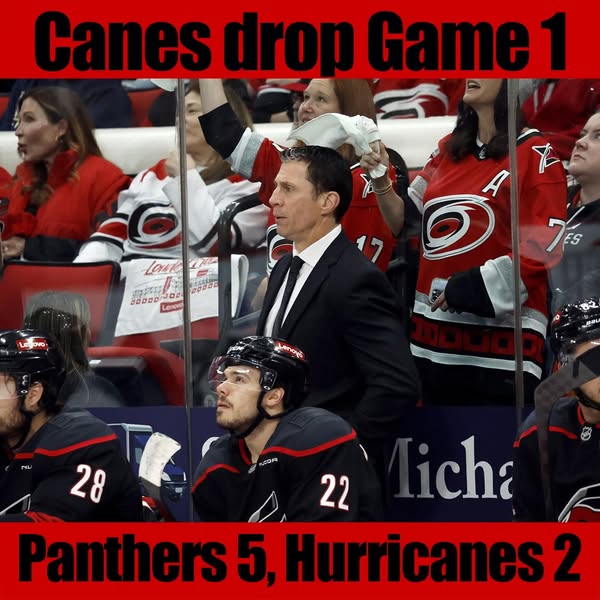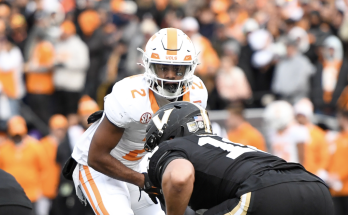The Carolina Hurricanes entered the 2025 Eastern Conference Final with high hopes, looking to take another step toward their elusive Stanley Cup championship. After a dominant regular season and an impressive playoff run, they were primed for a showdown with the Florida Panthers, who had earned their spot in the conference final with gritty, hard-fought wins. However, despite the anticipation and electric atmosphere at PNC Arena, the Hurricanes’ hopes of drawing first blood in the series were dashed as the Panthers emerged victorious, taking Game 1 with a 5-2 win.
A Rocky Start for Carolina
From the moment the puck dropped, it was clear that the Panthers were not intimidated by the high-pressure environment. Florida came out flying, showing why they had made it this far in the postseason. The Hurricanes, by contrast, looked slightly sluggish early on, unable to find their rhythm.
Within the first few minutes of the game, the Panthers seized control. Their aggressive forechecking and relentless pressure forced turnovers and disrupted Carolina’s usually smooth transition game. The Hurricanes’ defense, which had been solid throughout the playoffs, was caught off guard several times by Florida’s speed and physicality.
Florida’s first goal came just 6:14 into the game, when Aleksander Barkov capitalized on a rebound in front of Carolina’s net. A quick wrist shot from the point by Panthers defenseman Aaron Ekblad had hit the post, but Barkov was in the right place at the right time to put the loose puck past Hurricanes goalie Frederik Andersen.
Andersen, who had been outstanding in previous rounds, seemed a little off in the early stages of the game. His positioning was slightly off on a couple of shots, and despite his usually calm demeanor, the first goal seemed to shake him. He allowed another quick goal midway through the first period as the Panthers continued to generate offensive pressure. This time, it was winger Matthew Tkachuk who found the back of the net with a powerful slap shot from the left circle. The shot beat Andersen’s glove side, giving the Panthers a 2-0 lead.
Carolina’s Struggle to Respond
As the game progressed, Carolina seemed to be in a state of shock. The Hurricanes’ defense, usually known for its solid structure, was struggling to keep up with Florida’s high tempo. Carolina’s breakout passes were often intercepted or misfired, and the team couldn’t find any offensive flow. The normally lethal combination of Sebastian Aho, Andrei Svechnikov, and Teuvo Teräväinen was stifled by Florida’s tight coverage, and the Hurricanes’ power play, which had been a weapon in previous rounds, couldn’t get anything going.
By the time the second period arrived, Carolina was facing a daunting 2-0 deficit, and their task only grew tougher when Florida extended their lead further. At 7:30 of the middle frame, Sam Bennett found space in front of the net and redirected a shot from the point past Andersen, making it 3-0. The Hurricanes had yet to show much of an answer, and it seemed like Florida was firmly in control.
The Hurricanes’ Pushback
Despite the mounting deficit, Carolina wasn’t about to go down without a fight. After all, this was a team that had earned its spot in the conference finals with resilience, determination, and an ability to bounce back from adversity. Head coach Rod Brind’Amour made adjustments throughout the game, shifting lines and trying to spark some energy on the bench. Carolina’s pressure finally began to create some opportunities as the second period wore on.
The turning point came at 12:45 of the second, when Aho finally put the Hurricanes on the board with a perfectly placed wrist shot over the shoulder of Panthers goaltender Sergei Bobrovsky. Aho’s goal, which came off a beautiful pass from defenseman Jaccob Slavin, cut the lead to 3-1 and energized the Carolina bench. The fans in the arena, who had been quiet for much of the game, erupted in support of their team.
But just as it seemed Carolina might be building momentum, the Panthers struck back. Florida responded just 90 seconds later with a power-play goal by defenseman Brandon Montour, who hammered a one-timer from the top of the right circle. Andersen was screened on the play and didn’t see the shot coming, leaving the Hurricanes facing yet another two-goal deficit.
A Dagger in the Third Period
Heading into the third period, Carolina found themselves with little time to make up the deficit. With the Panthers up 4-1, the pressure was squarely on the Hurricanes to dig deep and mount a comeback. But it was clear that the wind had been taken out of Carolina’s sails. Florida’s defense tightened, and Bobrovsky made a number of key saves to keep the Hurricanes from getting any closer.
At the 5:32 mark of the third period, the Panthers put the game out of reach with their fifth goal. Tkachuk, who had been a thorn in the side of the Hurricanes all night, found the back of the net for the second time in the game, this time off a slick pass from Barkov in the low slot. The goal made it 5-1, and the PNC Arena crowd, once full of hope, began to empty out as the reality of the situation set in.
A Late Rally That Fell Short
The Hurricanes did manage to score one more goal before the final buzzer, with Teräväinen getting a shot past Bobrovsky with 3:11 left in the game, but by that point, it was too little, too late. The Panthers had already done enough to secure the win, and the final score of 5-2 was a clear indication of their dominance.
Despite the defeat, the Hurricanes showed some resilience with their late goal. But there was no disguising the frustration on their faces as they skated off the ice. Carolina had come into the game with a lot of confidence, but Florida’s high-intensity play, combined with timely goals and strong goaltending, had proven too much for them.
The Key Takeaways from Game 1
There were several important takeaways for both teams following Game 1 of the Eastern Conference Final. For the Florida Panthers, the victory showcased their ability to disrupt an opposing team’s flow and dictate the pace of the game. Florida’s speed, physicality, and opportunistic goal-scoring were on full display, and their ability to capitalize on turnovers was a major factor in their success.
Bobrovsky, who had been shaky in the first round, played with confidence and poise, making several key saves when Carolina was starting to find its game. His ability to shut the door in the second and third periods, especially after the Hurricanes’ power-play chances, was a critical element in the Panthers’ victory.
For Carolina, Game 1 was a tough pill to swallow. While there were flashes of their offensive potential, they were ultimately outplayed for much of the night. Andersen, despite some good saves, seemed a step behind at times, and the Hurricanes’ defensive game was uncharacteristically porous. The Carolina power play, which had been potent earlier in the postseason, was stifled by Florida’s penalty-killing unit, leaving the team with few chances to generate offense.
On the offensive side of things, the Hurricanes were too reliant on their top line, with Aho, Svechnikov, and Teräväinen failing to consistently break through Florida’s defensive structure. The Panthers made it clear that they could stifle Carolina’s top players and force other skaters to step up.
Looking Ahead
While Game 1 was a tough loss for the Hurricanes, the series is far from over. Carolina has shown throughout the postseason that they can rebound from adversity, and the team will need to regroup quickly as they head to Florida for Game 2. Brind’Amour and his players will likely be emphasizing the importance of staying disciplined, tightening up defensively, and capitalizing on their scoring chances.
For the Panthers, the message will be one of staying aggressive. Florida has proven that they can go toe-to-toe with any team in the league, and their success in Game 1 will surely boost their confidence. If they can continue to play with the same level of intensity and remain composed under pressure, they’ll be in a great position to take a commanding 2-0 series lead.
The stage is set for what promises to be an exciting and hard-fought series between two of the NHL’s top teams. Game 1 has shown that both teams have the skill, heart, and determination to make a deep run, and it’s clear that the battle for the Eastern Conference title will go down to the wire.



